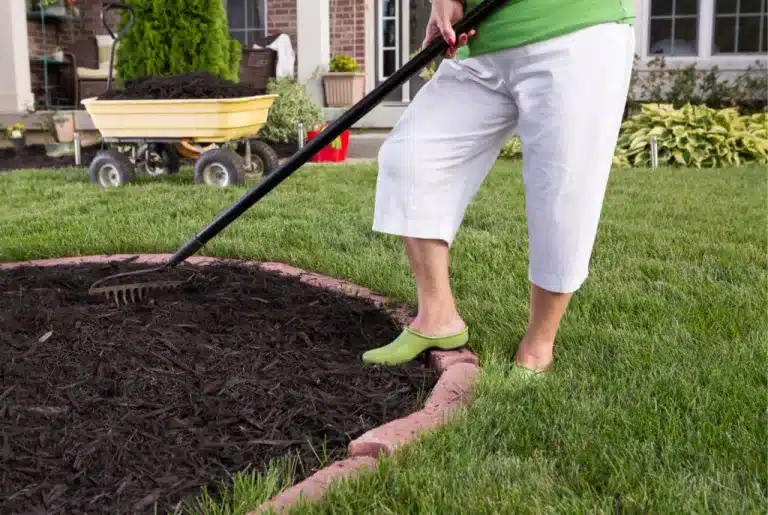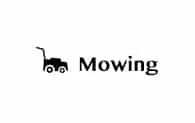Mulch Matters: The Key to a Thriving Garden
Introduction:
Installing mulch is a common landscaping practice used to improve the health and appearance of garden beds and landscape areas. It involves spreading organic or inorganic materials like wood chips or gravel around plant beds. Proper installation ensures even coverage and an attractive, functional garden. Regular care maintains its benefits.

Types of Mulch Installation
There are different kinds of manures accessible, each custom fitted to crop and soil necessities:
Hand Mulching:
This is the most common method of mulch installation. It involves spreading mulch by hand, using a shovel, rake, or pitchfork. Hand mulching allows for precise application around plants and trees. It’s a labor-intensive method but provides good coverage and control.
Machine Mulching:
For larger areas or commercial landscaping projects, machinery like mulch blowers or spreaders can be used to distribute mulch quickly and efficiently. Machine mulching is a land management technique that employs specialized equipment to shred or grind organic materials like leaves, branches, and brush.
Layered Mulching:
Layering mulch involves applying mulch in multiple layers to achieve greater thickness. By using this way of mulching, a great revolution occurs in the mulching field.
Weed Barrier Fabric:
It suppresses weed growth, conserves soil moisture, and prevents erosion. This solution allows water and nutrients to reach plants while reducing the need for harmful chemicals, making it an essential tool for sustainable landscaping.
Mulch Rings:
For individual trees and shrubs, creating mulch rings around their base can be beneficial. They are typically circular and should extend beyond the plant’s drip line. Mulch rings protect tree roots and add aesthetic value to landscaping while reducing maintenance requirements.
Topdressing:
If you already have mulch in place but it has decomposed or thinned out, you can add a fresh layer of mulch on top of the existing one. This is known as topdressing and helps maintain the benefits of mulch. This enriches soil, retains moisture, regulates temperature, and suppresses weeds. It enhances plant health, fosters nutrient cycling, and promotes a more vibrant and resilient garden ecosystem.
Mulch Beds:
Mulch can be used to create defined mulch beds within your landscape. These can be shaped and sized according to your design preferences and can help segment your garden or yard for different plants or features. Composed of organic materials like wood chips or leaves, they conserve soil moisture, inhibit weed growth, and regulate soil temperature.
Mulch Pathways:
In addition to mulching plant beds, you can create mulch pathways in your garden. These can be aesthetically pleasing and functional, allowing you to walk through your garden without compacting the soil. Composed of organic materials like wood chips or bark, they suppress weeds, conserve moisture, and regulate soil temperature.
Materials and Tools Needed:
- Choose the type of mulch that best suits your landscaping needs. Common types include wood chips, shredded bark, straw, compost, or gravel.
- A rake is used for tasks like gathering leaves, grass clippings, and debris, as well as leveling soil.A garden rake is useful for spreading and leveling the mulch.
- Wheelbarrows have a single wheel for easy transport of heavy loads, while buckets come in various sizes for carrying materials. Both aid efficiency and reduce physical strain, making them indispensable in countless industries and everyday chores.Wheelbarrows and buckets are essential tools in construction, gardening, and various manual labor tasks.
Advantages of Mulch Installation:
There are some of the key advantages of Mulch Installation:
Moisture Retention:
This can lead to reduced watering needs and more consistent soil moisture levels.By covering soil with organic materials like straw or compost, it acts as a protective barrier. This shields soil from evaporation, reducing water loss, and promoting consistent hydration for plants. Mulching also regulates soil temperature, fostering ideal conditions for healthy growth.
Soil Improvement:
Over time, organic mulches like compost or wood chips break down and add valuable organic matter to the soil. Over time, mulch decomposes, enriching the soil with valuable nutrients and enhancing its structure, promoting healthier plant growth and sustainable gardening practices.
Pest and Disease Management:
Some mulch materials, like cedar or cypress, contain natural compounds that repel certain pests and fungi, reducing the risk of infestations and diseases. However, improper mulching can harbor pests, so proper thickness and maintenance are crucial for its success.
Improved Plant Health:
Mulch helps protect plants from soil-borne diseases and damage caused by lawnmowers and string trimmers. Mulch contributes to improved garden health in numerous ways.Mulch also regulates soil temperature, fostering healthier root systems and plant growth. Ultimately, mulch enhances soil quality, fostering thriving, vibrant landscapes.
Noise Reduction:
Some mulch materials can help dampen noise in outdoor areas, making your garden or landscape more peaceful and enjoyable.Noise reduction mulching is an eco-friendly landscaping technique that involves using organic materials like wood chips or straw to cover soil. It dampens sound from footsteps, equipment, and traffic, making outdoor spaces quieter and more serene. Additionally, it conserves soil moisture, prevents weed growth, and enhances overall aesthetics.
Soil Erosion Control:
Mulching, the practice of covering soil with organic or synthetic materials, helps combat erosion by reducing the impact of these erosive forces. Mulch forms a protective barrier that shields the soil from raindrop impact, prevents wind from blowing away topsoil, and encourages water infiltration.
Tips while using Mulch in Garden:
- When using mulch in your garden, consider the following tips:
- Inorganic options include plastic or landscape fabric. Select mulch based on your garden’s specific needs and aesthetics.
- Apply mulch to a depth of 2-4 inches (5-10 cm) around your plants, being careful not to pile it up against the plant stems, as this can lead to moisture and disease issues.
- Avoid using mulch from questionable sources or mulches that may contain toxins or contaminants.
- There are some key reasons why mulch matters in gardening.
- Moisture Retention & Temperature Regulation:
- Regularly replenishing mulch is essential to sustain moisture retention benefits and promote overall plant vitality, making it an indispensable practice in gardening and landscaping.
- Proper mulch thickness and composition are essential for effective temperature regulation, ensuring optimal growing conditions for plants year-round while conserving moisture and promoting soil health.
- Soil Erosion Prevention:
- The protective layer of organic or inorganic material serves as a shield for the soil, effectively reducing erosion by wind and water. Moreover, mulch enhances soil structure, fostering healthier plant growth with stronger root systems, which further stabilizes the soil.
- Improved Soil Structure:
- Mulching is a sustainable agricultural practice that significantly enhances soil structure and quality. Mulch acts as a protective shield, shielding the soil from erosive forces like wind and rain, thus preventing topsoil loss and promoting soil stability. This, in turn, fosters improved aeration and water infiltration, resulting in healthier root systems for plants.
- Reduced Compaction:
- By providing a buffer between the soil and foot traffic or heavy equipment, mulch can help reduce soil compaction, which can be detrimental to plant roots. Reduced compaction also minimizes erosion and contributes to a more resilient and productive garden environment.






